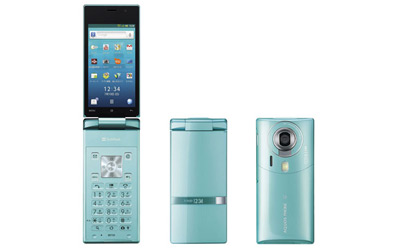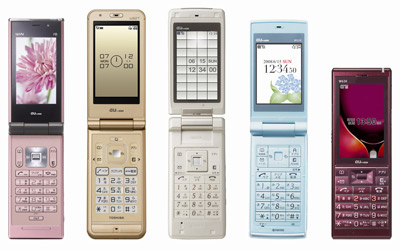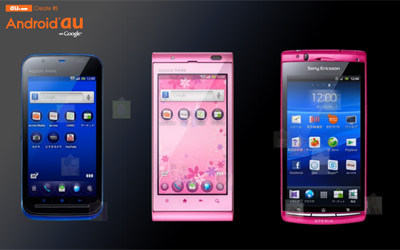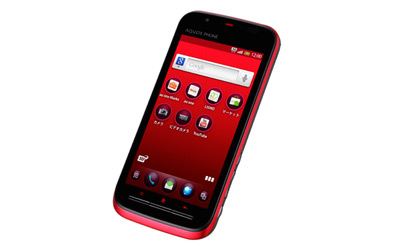Why Android will dominate Japan

Sharp is releasing an Aquos Android clamshell phone with a 16-megapixel camera running Gingerbread. This is the latest step in Android’s quiet and gradual takeover of the Japanese phone market. I believe that Japan will eventually become a strategic stronghold for Android and in turn this will serve to shore up Google’s historically weak performance against Yahoo in search and online services in Japan.
Japanese Market
The mobile phone market in Japan has always suffered from the Galapagos syndrome. Clamshell phones developed in Japan by companies such as Casio and Sharp can find little demand in other markets, while on the flip-side, international titans like Nokia and Blackberry never had any significant presence in Japan.
Some believe that Japanese consumers simply dislike foreign products because they are not Japanese while pointing to examples such as the Xbox 360, but Apple’s success with iPod demonstrates that that is a superficial argument. The more likely explanation is that Japanese consumers have quirky demands that are often not part of the design considerations for overseas companies.

Most phones in Japan still look like these
The iPhone has found greater success in Japan than any other foreign-made phones, but its presence is nowhere close to the level of ubiquity it commands elsewhere. That is because as much as iPhone and Apple are considered hip brand names in Japan, Apple’s brand philosophy does not allow the iPhone to be customized for the Japanese market beyond adding emoticons to the soft keypad. The poor-performance camera, the lack of Mobile FeliCa contactless payment and the lack of 1seg digital receiver are severe disadvantages in the Japanese market and these cannot be resolved without custom hardware.
At the same time, Japanese keitai phones are rapidly falling behind in terms of software, a traditional area of weakness for the Japanese tech industry. New keitai models being released today are still running heavily modified variants of Symbian, an outdated platform that has been dead for years and recently abandoned by its primary proponent Nokia in favour of Windows Phone 7. The Japanese industry needs a new platform fast but is incapable of creating one.
Android’s Rise
This is where Android comes in. Unlike iOS, Android is flexible enough to be adapted for all the range of hardware required by the Japanese market.
Microsoft’s Windows Phone 7 doesn’t even have support for Japanese input yet. Microsoft has traditionally been inept at marketing for Japan and its mobile division clearly does not see Japan as an important market. Furthermore, WP7 also comes with stricter hardware guidelines (e.g. capacitive touchscreen) that are unlikely to fly well with the clamshell phones that Japanese school girls love so much.

Android au KDDI selections
The process has already begun. Android has already replaced Windows Mobile 6.5 in the smartphone market in Japan. Just take a look at the smartphone offerings for the three major providers: Docomo, au KDDI and Softbank. They are dominated by Android, save for maybe one WM6.5 and one Blackberry. The only real competition in this sector is the iPhone, which is doing quite well as Apple products enjoy the cool factor even in Japan.
For the past few months, KDDI has been running a series of Android ads called “Android au” in multiple media formats, a campaign that is reminiscent of Verizon’s successful Droid campaign which is often cited as the reason for the sudden explosion in popularity of the Android platform. The KDDI Android ads include endorsement by boy band Arashi and prime-time TV spots, suggesting that KDDI is rather serious about committing to the platform for the long term.
Android’s Dominance
Last year, it was reported that iPhone took up 72% of the smartphone market in Japan in FY 2009. This sounds very impressive at first, until one realizes this is because a smartphone market didn’t exist and even high-end keitai phones are not considered smartphones. In actuality, Apple’s overall 2009 mobile marketshare in Japan amounted to a mere 4.9%. (Source: MM Research Institute)
In the fiscal year 2010, which had just ended, Android sales exploded and took up 57% of the Japanese smartphone market with 4.91 million units sold, while Apple fell to 38% with 3.23 million units. (Source: Bloomberg) With the support of KDDI and OEM giants like Sharp, Android’s lead in the smartphone market appears to have been secured. But beating Apple is just the first step.
The real battle lies in the keitai market, the vast majority of the Japanese mobile industry, and this is where Android will cement its dominance. The iOS is not even in play here due to its hardware dependency and there is no other competing OS platform with the same long-term potential and developer support that Android has. Furthermore, Japanese users expect their keitai interface to conform to certain norms and Android is really the only modern smartphone OS malleable enough to fit that mould and displace Symbian. Sharp’s new clamshell phone marks the beginning of this process.
Implications
For Japanese keitai manufacturers such as Sharp, Android is the most obvious way to leap-frog their phone firmwares to modern specifications without compromising on the traditional user experiences that Japanese users require.
This also has the long-term benefit of finally making their products export-ready (e.g. Sharp’s Galapagos is heading to the US with Android) and cutting down unnecessary R&D previously spent on replicating modern OS features on Symbian. Sharp’s new Android smartphones, such as the IS12SH with 3D cameras, are basically ready for the overseas market with a simple firmware change.

Sharp IS12SH Android smartphone
In the long run, Android is essentially going to win by default in Japan simply due to the lack of alternatives. One day, Japanese school girls will be buying Android clamshells and they won’t even notice the difference. This transition may also prove to be an excellent opportunity for Japanese hardware makers to re-enter the international market after losing badly to companies like Samsung and Nokia.
I for one welcome our new Android overlords.







May 22nd, 2011 at 9:09 pm
I’m not convinced. Certainly Android is the best bet, but I’m not sure that any of the current competing smartphone operating systems will ever really catch on in a huge way there. Android is the most likely one to do so, but I’m not convinced it will actually offer anything compelling enough to make customers – and by extension, manufacturers – ditch their current software.
As far as WP7 goes, I believe that Japanese input is coming in their ‘mango’ update. I’d imagine that a lot of the Windows 6.5 devices that Android has displaced were in the pockets of more corporate-oriented users, and Android isn’t really pitched at that market, so there’s a possibility that once WP7 actually has Japanese input support, we could see a swing back the other direction. Maybe. I doubt it though.
May 22nd, 2011 at 9:17 pm
Pretty much.
Tho the story doesn’t stop there. Android development coming from the hardware manufacture perspective has one major challenge: os frag. Tho for most markets, it’s uncertain if that is a real problem as it’s too early to tell; 2.1 was the first version that most non-US markets got en masse, and that one works just fine for the majority of apps. Off the top of my head, I think the very first Xperia was a 2.0.1, for Japan? And that was it?
May 22nd, 2011 at 9:24 pm
Oh, right, to address NZ: Android is going to dominate (is already) the mid to upper-mid range phone market, beating out most featurephones. In Japan, that’s also going to happen given the offerings the carriers do.
I think that’s what DM is talking about. Low range, who knows.
May 22nd, 2011 at 9:57 pm
Omo:
I don’t think OS fragmentation is really an issue here. In fact, fragmentation has basically always been the default state of business for the industry. So this shouldn’t matter from the manufacturers’ perspective anyway.
Especially in Japan’s case where the service providers are basically the ones who dictate the technical specifications for phones. As long as all the Android phones run the providers’ list of custom apps like train schedulers and mobile payments, no one will care how far the phones deviate from vanilla Android.
Fragmentation matters only in terms of competition for apps with iOS and WP7. But iOS and WP7 are incapable of meeting the list of functionalities that keitai serve in the Japanese market, so they don’t matter in this case.
NegativeZero:
WP7 threw away all its roots and is further away from being a “corporate phone” than iOS. In terms of design philosophy, Android is actually a lot closer to WM6.5 and is similarly suited for the long list of software customizations that Japanese OEMs like to make.
Other than maybe Nokia, I don’t think anyone is going to receive permission from Microsoft to customize the WP7 UX and that’s just not going to fly in the Japanese market.
The problem with WP7, and Microsoft in general, in Japan is basically a cultural one and it goes far deeper than just language support. Well actually, I have doubts about WP7′s future in markets outside of Japan too. It’s basically dead in Singapore despite officially launching here.
May 22nd, 2011 at 10:25 pm
NegativeZero:
Also the thing is that keitai phones are basically featurephones with overpowered specifications. There isn’t the same kind of app-lock that happens with smartphones when you switch from Android to iOS and lose all your Market purchases.
If you have Androids running on clamshells offering the same network services as previous clamshells, the end users will notice nothing. Most features offered by keitai are network-based services provided by the ISPs and have nothing to do with the software platform.
May 23rd, 2011 at 1:24 am
+1 Agree. Good analysis, and yes, I think Android is the right fit for the Japanese market, precisely because it’s a robust platform and easily extensible.
One observation about the state of software engineering in Japan:
Laziness is actually one of the greatest assets a programmer can have. A sufficiently lazy programmer will eventually reduce his effective workload, and by extension the workload of those around him, to a value approaching Zero – just look at the crazy package management and build automation systems available on GNU/POSIX platforms.
Laziness is, unfortunately, not generally a characteristic of your typical Japanese person. Kicking back on a sofa and having a beer while your code builds itself is probably just not something that flies well in a culture where keeping up appearances is important. As a result, there is basically a meme that states that writing lots of custom, intricate code in your application will result in something that runs better.
In some ways, this is true in a limited sense – writing everything by hand does generate results that work extremely well in a user’s hands. However, the realities of economics kick in, and suddenly it’s clear that there just aren’t enough programmers to go around doing this for every piece of software that gets written. On the other hand, there is a lack of extensible, generic frameworks due to this very practice. So in the end, it’s hard to write any good amount of software when adhering to this meme.
May 23rd, 2011 at 2:14 am
An article about android and Japan without a single word about Sony Ericsson? How odd…
May 23rd, 2011 at 7:45 am
will it be usable locally without without any restrictions?
May 25th, 2011 at 12:38 am
Microsoft inept at marketing in Japan? Say it ain’t so! I mean, look at their Windows mascot: http://msdn.microsoft.com/ja-jp/windowsazure/claudia ;)
In all seriousness though, as an Android device owner, I welcome the advancement of the platform in Japan. Android is extremely versatile and can be modified to fit it’s intended userbase. That’s something Apple will never do. They expect the userbase to conform to them instead ;)
So while it satisfies the tech geek in me, it can also be easy enough for normal school girls to use without a second thought. And, yeah, that’s why Android will win.
May 25th, 2011 at 8:48 am
Just one quibble: the Sharp IS12SH will not work outside Japan “with a simple firmware change”. Its a CDMA2000 device, while most of the world (including Singapore) uses GSM.
And its not as simple as swapping the GSM radio for a CDMA one either. The architecture between the 2 systems are vastly different. Basic things that are taken for granted in GSM (like overflowing SMS’es) don’t exist in CDMA2000. Just look at how long it took Apple to get their iphone to work with Verizon (one of the largest CDMA operators in the world).
Android may dominate Japan, but unless the Japanese hardware OEM’s can shake their shackles from their carrier overloads, they’re not going to make much headway outside Japan (Sony Ericsson may be the exception).
Which is a shame really, as the Japanese are brilliant in hardware design.
May 28th, 2011 at 7:26 pm
moody: I don’t really consider Sony Ericsson a Japanese keitai company. Its market share in Japan is tiny and it has always been better in overseas markets. Compared to Sharp which is the complete opposite and wields a much greater influence when it comes to Japanese keitai. If Android takes off in Japan, it will not be because of Sony Ericsson.
May 31st, 2011 at 11:33 am
Good analysis, DM.
There’s one thing I really don’t understand though: smartphones have been made available in Japan for I don’t know how long (iPhones and Android), yet we still don’t find those keitai features for typical smartphones. I would be surprised if all of Japan have keitai phones…it would make sense to have those keitai features for everyone, including smartphone owners. Correct me if I’m wrong.
Yes Android would dominate Japan, but only if japanese carriers and manufacturers would wake up and realize there’s also a market for smartphones…